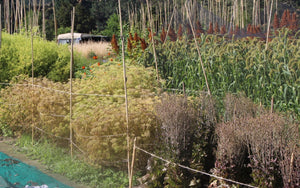Seed saving at Koanga Gardens

It all started with fruit trees. Living in Northland and wanting to grow her own fruit, Kay Baxter looked around to see which fruit trees were doing well in the area, but noticed that few people were growing their own and that those sold at the garden centres did not fare well. ‘The root stocks and the cultivars had been selected for export’, explains Kay. This meant the fruit trees sold were chosen based on what would do well in the regions where commercial fruit growers were based – in colder parts of the country with good soils. But wild fruit trees seemed to grow well, particularly those located ‘where our ancestors had originally landed’.
Over a ten-year period, Kay developed a collection of plant material from the old house sites around the Kaipara and Hokianga harbours and further afield in Northland. She started to learn ‘about the stories of those trees and the families, and began to understand that the story of these trees was our own people’s story too’. The taste was also a revelation – suited to growing in the region, these fruits expressed their best selves. From here Kay, with her husband Bob, began selling fruit trees through what began as ‘Koanga Gardens’.
But seeds – intersecting with a major global event and a chance conversation – were to be the next part of the story. The Chernobyl disaster’s impact had reached some of Kay and Bob’s friends who were organic farming in Holland: ‘We knew that they had had a lot of nuclear fallout on their land’. This thought was in the back of her mind when she went on a garden club trip to the Mystery Creek Farmers’ Field Day. Kay wandered into the seed tent and struck up a conversation with the person manning it, who told her that the vast majority of seeds for purchase in New Zealand were not grown here, but in Holland. Kay was struck cold: ‘How could we, in this land, have become so dependent on the Northern Hemisphere for our food security?’ These concerns were further compounded by health worries and having four young children at the time. Kay decided to do something about it, she just didn’t know what: ‘I had never heard of seed saving.’
The next week, after having been on the waiting list for some time, Kay ended up at her first Kaiwaka Garden Club meeting, the members of which were mostly elderly women. When she arrived, a woman walked up to her and said, ‘You’re that lady who saves the fruit trees, you might like these bean seeds.’ All the ladies there were familiar with these beans, which they considered to be the ‘best-tasting’, even though you could not buy them anywhere.
The experience made Kay realise that these older gardeners, ‘the last generation that grew their own food’, had stocks of New Zealand grown and adapted seeds. They knew the importance of those seeds and had no one to hand them down to in their families, because their children, the baby boomers, had lost connection with the garden due to their modern lifestyles. A little while later an article appeared in the NZ Gardener about what Kay was up to, and soon seeds and letters were pouring in from around New Zealand. Koanga Gardens became the Koanga Institute to cope.
Today the Koanga Institute holds 800 vegetable seed lines, most of which are New Zealand heritage cultivars, and several hundred fruit seeds. ‘It’s a huge job growing these seeds out and we have never had any serious funding or support other than from our members, which has kept Koanga alive by a thread.’ It is a vocation that is both humbling and inspiring. Kay has worked there for very little for most of her adult life simply because she believes in providing people access to these important food stocks. The Koanga Institute has accordingly instigated a campaign to extend its membership to 5000 people to support its staff and activities.
The way Kay sees it is that preserving this seed collection is essential for our future, as it is a means to maintaining biodiversity and nutritionally rich foods, and to connecting us to our ancestors through shared foods. With workshops, apprenticeships and volunteers, the Koanga Institute spreads and preserves this knowledge. For Kay it is all about redressing the separation that the dominant agricultural model has installed – one that ignores connectivity along the food production chain. It involves respecting the way the soil, environment, food and our health are all intertwined. What is of critical importance to Kay and the staff who work at Koanga Institute is preserving seeds and promoting their value to Aotearoa, which is multifaceted: cultural, historical, environmental, nutritional and very much in keeping with principles of kaitiakitanga.
Image : by Kay Baxter. Koanga Institute holds hundreds of heritage cultivars.
Extract from Kai and Culture: Food Stories from Aotearoa, edited by Emma Freeman (Freerange Press, 2017). If you would like to buy your own copy of "Kai and Culture", click here.






